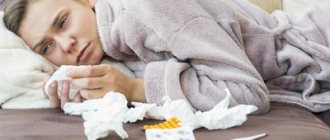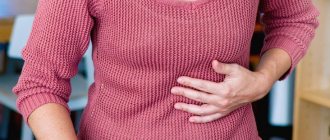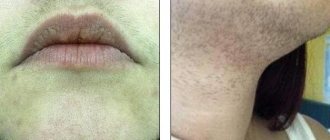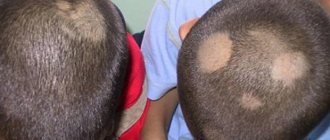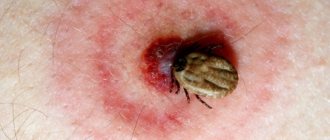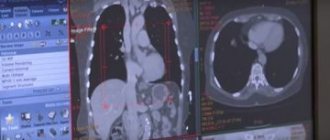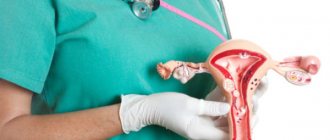Mastopathy is a diffuse or nodular pathological change that occurs in the soft tissues of the mammary gland. The disease begins to develop as a result of hormonal imbalance in a woman’s body. When the first characteristic symptoms occur, you must consult a doctor to prevent complications and the development of more serious diseases. Let's figure out why mastopathy is dangerous.
Structure and regulation of mammary glands
The mammary gland is a paired organ and is represented by three types of tissue. The main one is parenchyma or glandular tissue, in which ducts of various diameters pass; the glandular tissue is divided into lobules and lobes (there are about 15 - 20 of them). The lobules and lobes are separated by stroma or connective tissue, which makes up the framework of the mammary gland. And the third type of tissue is adipose tissue, it is in it that the lobules, lobes and stroma of the mammary gland are immersed. The percentage of parenchyma, stroma and adipose tissue is directly related to the physiological state (age) of the reproductive system.
During gestation, the mammary glands reach morphological maturity. Their size and weight increase, the number of lobules and ducts increases, and milk secretion begins in the alveoli (the morphomolecular unit of the mammary gland). After childbirth, due to the production of milk, the mammary glands increase even more (lacteal sinuses are formed in the ducts of the lobes, in which milk accumulates). And after the cessation of lactation, involution occurs in the mammary glands, and the stroma is replaced by adipose tissue. With age (after 40), the parenchyma is also replaced by adipose tissue.
Both the growth and development of the mammary glands are regulated by numerous hormones. The main ones are estrogens, progesterone and prolactin. A role in regulating the development of mammary glands and somatotropic hormone has also been proven. The main changes in the mammary glands under the influence of hormones are the parenchyma, and to a lesser extent the stroma is subject to hormonal influence. The condition of the mammary glands depends on the ratio of the content of these hormones. When the hormonal balance is disturbed, mammary gland mastopathy develops.
Why is fibrocystic mastopathy dangerous?
Cystic fibrous mastopathy is a benign neoplasm of the mammary glands. Without treatment or improperly selected therapy, the tumor can become malignant. This disease is dangerously fatal for the patient. To exclude complications, before treatment, doctors give an injection and take a puncture to reliably determine the nature of the pathology. Fibrous mastopathy of the mammary glands is a curable disease, the main thing is not to start the pathological process.
Find out more about what breast puncture is.
Forms of mastopathy
In modern medicine there are a large number of classifications of this disease. The following is considered the most convenient in clinical work:
Diffuse mastopathy
- when the glandular component predominates, they speak of adenosis;
- mastopathy in which the fibrous component predominates (fibrous mastopathy);
- mastopathy, in which the cystic component predominates;
- mastopathy of mixed form;
Nodular mastopathy
- lipoma;
- fibroadenoma;
- breast cyst;
- lipogranuloma;
- intraductal papilloma (roughly speaking, a wart in the milk duct);
- breast hematroma;
- angioma.
In the case of damage to both mammary glands, they speak of bilateral fibrocystic mastopathy, and if the process develops in one gland, it is said to be unilateral (for example, a cyst of the left mammary gland).
Depending on the severity of clinical manifestations, the disease can be mild, moderate or severe.
In addition, both diffuse and nodular mastopathy can be of proliferating and non-proliferating forms. Fibrocystic mastopathy (FCM) of the first form is prognostically unfavorable. In this case, proliferation of the epithelium of the milk ducts occurs, which leads to the formation of intraductal papillomas or proliferative changes in the epithelium of the internal walls of the cysts, which leads to the development of cystadenopapilloma.
All the described changes are fraught with malignant degeneration and are dangerous for the development of breast cancer.
A special form of the mammary gland also appears at the end of the second phase of the cycle, which is called mastodynia or mastalgia. Mastodynia is caused by cyclic engorgement of the gland due to venous stagnation and stromal edema, which leads to a sharp increase and soreness of the mammary gland (more than 15%).
Traditional treatment of fibrocystic mastopathy
Doctors prescribe medications strictly according to indications. Treatment of fibrocystic mastopathy with folk remedies is only an auxiliary therapy that accelerates the process of tissue regeneration. The first thing you need to do is make sure there are no contraindications, enlist the support of doctors, and choose the right medicinal herbs. This is an effective method of intensive therapy, available to the patient at home. If fibrocystic breast disease progresses, effective recipes are as follows:
- Dissolve a matchbox of propolis in 500 ml of vodka and leave for 2 weeks. Use as compresses, apply to the sore breast up to 2-3 times a day.
- Boil the pumpkin in water, mash with a fork, place while warm on gauze and apply to the suspected site of pathology. Perform the procedure at night.
- Mash a fresh burdock leaf to release the juice. Tape it to the sore chest for several hours. Take up to 4-5 times daily doses.
Herbs
Herbal medicine also relieves inflammation and alleviates the patient’s general condition. When choosing effective herbal remedies for fibrocystic mastopathy, it is recommended to pay attention to the following natural ingredients: immortelle, cinquefoil, immortelle, agrimony, wormwood. In limited quantities, plant poisons such as mistletoe, celandine, and hemlock can be used. Red brush, aloe, and echinacea have immunostimulating properties.
Causes
The etiological factors and the mechanism of development of the disease are caused by hormonal imbalance. The leading role in the formation of mastopathy is given to conditions in which there is progesterone deficiency, impaired ovarian function and/or absolute or relative hyperestrogenism. This is due to the fact that estrogens promote the proliferation of epithelium in the alveoli, milk ducts, and enhance the activity of fibroblasts, which causes proliferation of the stroma. Also in the mechanism of formation of the disease, hyperprolactinemia and excess prostaglandins are also important (causing mastodynia, and then mastopathy). For the development of hormonal imbalance, the action of provoking factors is necessary. But even with their existence, mastopathy does not develop immediately, since it requires their long-term influence (several years) and “layering” of one factor on top of another. Such provoking factors include:
- early menarche (early puberty, up to 12 years, leads to rapid hormonal changes, which also affects the condition of the mammary glands);
- late menopause (cessation of menstruation after 55 years is also unfavorable for the mammary glands due to prolonged hormonal effects on their tissue);
- termination of pregnancy (a sharp hormonal decline after an abortion or miscarriage leads to hormonal disorders and the development of mastopathy);
- there were no pregnancies or childbirths at all;
- short period of lactation or categorical refusal to breastfeed;
- heredity (benign and malignant breast diseases in women on the maternal side);
- age (over 35);
- stress as a cause of endocrine pathology;
- bad habits;
- injuries to the mammary glands, compression of the chest by a tight and uncomfortable bra;
- inflammatory processes of the mammary glands;
- hormonal-dependent gynecological diseases (cycle disorders, anovulation and infertility, fibroids, endometriosis);
- iodine deficiency;
- pathology of the liver, thyroid gland;
- obesity (adipose tissue acts as an estrogen depot, and their excess leads to hormonal disorders);
- tumors of the hypothalamus and/or pituitary gland (failures in the production of FSH and LH lead to hyperestrogenism);
- irregular sex life or dissatisfaction with sex, which contributes to stagnation of blood in the pelvic organs and, as a result, causes dysfunction of the ovaries and hormonal imbalance.
Cystic fibrosis of the lungs - symptoms
The first signs of cystic fibrosis are often recorded at an early age, but the manifestation of the disease can occur in adolescence and even adulthood. The clinical picture develops in the case of infection of bronchial cysts, which provokes an inflammatory process:
- A characteristic symptom of cystic fibrosis with lung damage is a wet cough, which is accompanied by the release of purulent or purulent-mucous sputum, and in some cases, hemoptysis.
- At the same time, signs of intoxication of the body and cardiopulmonary failure appear.
Children suffering from this disease experience systematic damage to the lungs and bronchi. Periods of inflammation are followed by remission.
During a relapse of the disease, the following symptoms appear:
- increase in the volume of secreted sputum;
- painful sensations in the chest;
- increased body temperature;
- general weakness;
- cyanosis of the nasolabial triangle;
- growth slowdown;
- frequent infections of the lungs and bronchi;
- bloating;
- constipation;
- weight loss;
- lowering blood pressure;
- barrel-shaped deformation of the chest;
- deformation of the phalanges of the fingers.
Symptoms
With mastopathy, the symptoms and their severity depend not only on the form of the disease, but also on the emotional state and character of the woman and on existing concomitant pathologies. In the mastopathy clinic, the following symptoms predominate:
- Mastodynia or breast tenderness
Pain syndrome can be of varying nature and intensity. In the initial stage of the disease, chest pain appears on the eve of menstruation, which many women regard as premenstrual syndrome. The pain can be dull, aching, or so sharp that it is impossible to touch the chest. The pain syndrome is caused by stagnation of blood in the veins and tissue swelling and is described by patients as breast engorgement. Women also note an increase in the volume of the mammary glands (edema). After menstruation, the pain disappears, but as the pathology progresses, the pain becomes constant, only its intensity changes depending on the phase of the cycle. Severe pain also negatively affects the psycho-emotional state of a woman. In addition to sleep disturbances, mental lability is noted, irritability, aggressiveness and tearfulness appear.
- Nipple discharge and breast lumps/lumps
Discharge from the nipples is a characteristic, but not obligatory symptom of mastopathy. The severity and color of the discharge also varies. The discharge may be insignificant and appear only when the nipple is compressed, or it may occur independently, as evidenced by stains on the underwear. The color of the discharge may be whitish or transparent, or greenish, which indicates a secondary infection. The appearance of discharge from the breast indicates involvement of the milk ducts in the process. An unfavorable prognostic sign is the appearance of brown or bloody discharge, which is characteristic of malignant tumors.
Diffuse mastopathy
It is more often diagnosed in young women, and palpation reveals enlarged and painful mammary glands with rough heaviness and pronounced lobulation, as well as fine granularity.
Nodular mastopathy
Nodular is the next stage in the development of the disease, which occurs in the absence of treatment for the diffuse form of the pathology. Palpation of the mammary glands allows you to feel with your fingers individual or individual areas of the lump or cyst. Foci of compaction are palpated as dense nodes without obvious boundaries with pronounced lobulation. The nodes can reach impressive sizes (up to 6–7 cm). In the case of the formation of a mammary gland cyst, round or oval elastic formations with obvious boundaries that are not connected with the surrounding tissues are palpated.
The danger of mastopathy
Mastopathy is a benign disease. But, any pathological changes in the mammary gland are not the norm. Every girl and woman should know how dangerous mastopathy is if it is not treated. Without treatment, there is a risk of serious consequences:
- Development of mastitis. This disease is characterized by inflammation of the soft tissues of the chest. The disease develops in women during lactation. But in some cases, mastitis becomes a consequence of mastopathy. Nodular neoplasms block the milk ducts, causing stagnation of milk in the breast.
- The appearance of cracks in the nipples. As a result, patients develop inflammation of the mammary glands. Pathogenic microorganisms penetrate inside through cracks.
- Sepsis or soft tissue necrosis. These are serious and dangerous consequences of the disease. They require radical measures. Doctors often prescribe breast resection to patients.
- Cancer. With the progression of mastopathy, there is a possibility of degeneration of a benign neoplasm into a malignant one.
Any tumors and nodes in the chest require timely treatment. Nodular mastopathy is characterized by the formation of a neoplasm, so girls and women need to pay attention to their health and well-being. This disease often causes active cell division and proliferation of soft tissues.
Diagnostics
Diagnosis of the disease begins with collecting anamnesis and complaints. After the survey, the patient’s doctor examines and palpates the mammary glands. During the examination, the contours of the breast, the presence/absence of asymmetry of the mammary glands, skin tone and venous pattern, the position of the nipples and whether there is any deformation are clarified.
Next, the mammary glands are palpated (necessarily in the first phase of the cycle) in two positions: standing and lying, since some formations may not be palpable in one position. In addition, the doctor squeezes the nipples and determines the presence/absence of discharge from them, and also palpates the regional lymph nodes (axillary, sub- and supraclavicular).
Instrumental methods for diagnosing mastopathy include:
- Mammography
The essence of this method is an X-ray examination of the chest. Mammography is indicated for women at significant risk for breast cancer, as well as all women 35 years of age and older during medical examination. inspection. X-rays of the mammary glands are performed in the first half of the cycle (days 7–10) and always in 2 projections (frontal and lateral). The advantages of mammography include high information content (up to 97%) and the ability to detect non-palpable formations.
- Ultrasound of the mammary glands
This examination is indicated for women under 35 years of age, as well as for pregnant and breastfeeding women. The advantages of the method are harmlessness and safety, high resolution, the ability to examine breast implants or in case of existing trauma and/or inflammation of the breast, and the ability to examine regional lymph nodes. Among the disadvantages of the method: it is impossible to examine the mammary gland as a whole, but only a “slice”, little information content in case of fatty degeneration of the breast, subjective assessment of the images (depending on the qualifications and experience of the doctor).
- Needle biopsy
If a suspicious area (compaction or cavity formation) is identified, a fine-needle puncture of the pathological focus is performed, followed by a histological examination of the contents.
- Hormonal status study
First of all, the level of estrogen and progesterone is determined; if hyperprolactinemia is suspected, the level of prolactin is determined, and if necessary, adrenal and thyroid hormones are examined.
- Ultrasound of the pelvic organs
It is carried out to exclude diseases of the ovaries and uterus.
- Blood chemistry
Liver enzymes, blood sugar and other indicators are examined to exclude concomitant extragenital diseases.
In addition, additional methods for examining the mammary glands include (if necessary) ductography (examination of the milk ducts), pneumocystography (examination of cavity formation), laser and digital mammography, thermography, and magnetic resonance imaging.
Is it possible to cure mastopathy on your own?
Self-medication of mastopathy is unacceptable, since it is impossible to identify the cause and form of the disease without a comprehensive examination and consultation with a mammologist. Many women try to treat this disease on their own using folk remedies, but this attitude towards their health can cause the development of breast cancer, since mastopathy is considered by all specialists as a precancerous disease.
Only long-term and comprehensive treatment aimed at eliminating the causes of the disease will help you get rid of mastopathy. In some cases, it can be supplemented with traditional methods, but their use should always be discussed with a doctor and combined with the main therapy.
Patients with mastopathy may be recommended sedative, choleretic, diuretic and restorative herbal infusions, which in some cases can be an alternative to pharmacological agents. Before using them, it is necessary to exclude all possible contraindications to their components.
To treat mastopathy, your doctor may recommend various traditional recipes.
Linseed oil
Flax contains substances that help normalize hormonal levels and Omega-3, which help activate the body's anti-cancer defenses. Flax oil can be prescribed in capsule form or in its pure form.
Infusion or decoction of Rhodiola cold (or red brush)
This medicinal plant has an anticarcinogenic effect and promotes:
- normalization of estrogen and progesterone levels;
- restoration of the functions of the endocrine glands;
- elimination of inflammatory reactions in the mammary glands;
- strengthening the immune system;
- removing toxic substances from the body.
One or more courses of taking an infusion or decoction of red brush helps eliminate pain and swelling of the glands, stop discharge from the nipples and reduce the size of the nodes. In addition, taking this medicinal herb is recommended for concomitant diseases such as uterine fibroids, cervical erosion, inflammatory processes in the genitals and infertility.
Infusion of horse chestnut flowers
To eliminate inflammatory processes in the mammary glands and pain due to mastopathy, it may be recommended to take an infusion of horse chestnut flowers. A teaspoon of plant material is poured into a glass of boiling water and left for half an hour. The strained infusion is taken in between meals, 1/3 cup three times a day.
Compresses with cabbage leaves
To reduce pain due to mastopathy, you can use cabbage leaves. They are applied to the chest in the evening or at night and secured with a bra. Instead of cabbage leaves, you can use burdock, and to enhance the effect, put a mixture of 3 parts grated beets and 1 part honey under the leaf.
Lotions with wormwood infusion
You can eliminate mastalgia with the help of lotions made from wormwood infusion. To do this, pour 5 tablespoons of plant material into 3 cups of boiling water and leave to steep overnight. After this, the infusion is filtered, a little warm water is added, linen or cotton cloth is moistened in it and applied to the chest for 15 minutes three times a day.
Compresses made from burdock leaves, honey and castor oil
Such compresses are prepared from crushed burdock leaves (100 g), two lemons, castor oil (100 g) and honey (100 g). The components are mixed, applied to a linen or cotton napkin and applied to the chest overnight.
Herbal collection of wormwood, nettle, sage and plantain
To prepare the collection, take two parts of wormwood and one part each of nettle, sage and plantain. A tablespoon of the mixture is poured into 220 ml of boiling water and left for an hour. The infusion is filtered and taken ½ glass 20 minutes after meals three times a day. The course of admission is 2 months. After 14 days the course can be repeated.
Mastopathy is a precancerous disease and requires complex treatment from a specialist. The treatment plan may include non-hormonal and hormonal agents, the use of which is aimed at eliminating the causes of the disease. In some cases, a woman may be recommended surgical treatment.
Treatment
When mastopathy is detected, treatment must be carried out without fail and its tactics depend on a number of factors: the age of the patient, the form of the disease, the presence of concomitant pathology, interest in pregnancy or contraception. Fibrocystic mastopathy involves treatment both conservatively and surgically.
Patients only with a diagnosed form of diffuse mastopathy are subject to conservative treatment, and after consultation with a mammologist-oncologist. Conservative therapy is carried out with non-hormonal and hormonal drugs.
Non-hormonal treatments
- Vitamins
Vitamin A is prescribed, which has an anti-estrogenic effect, vitamin E, which enhances the effect of progesterone, vitamin B6, which reduces the content of prolactin, vitamins PP, P and ascorbic acid, which strengthen the vascular wall, normalize microcirculation and reduce swelling of the mammary glands. In addition, all of the listed vitamin preparations improve liver function, where estrogens are inactivated and generally have a beneficial effect on mammary gland tissue.
- Iodine preparations
Iodomarin and iodine-active are used, which normalize the functioning of the thyroid gland and participate in the formation of its hormones (see symptoms of iodine deficiency, medications).
- Sedatives and biostimulants (adaptogens)
Prescribing sedatives (motherwort, valerian, peony tincture) normalizes the patient’s psycho-emotional state, improves sleep and increases resistance to stress. Adaptogens (eleutherococcus, radiola rosea) stimulate the immune system, normalize metabolic processes in the body, improve liver and brain function.
- Herbal remedies
Mastodinone, cyclodinone or remens are used, which have a beneficial effect on hormonal balance, eliminate pathological processes in the mammary glands, and reduce the concentration of prolactin.
- NSAIDs
The administration of drugs such as indomethacin, nise or diclofenac not only reduce pain by suppressing the synthesis of prostaglandins, the “causative agents” of pain, but also relieve swelling and engorgement of the mammary glands.
- Diuretics
Diuretics (Lasix or herbal diuretics: lingonberry leaf, kidney tea, phytolysin) help reduce swelling in the mammary glands and reduce pain.
Hormone therapy
This is the main link of conservative treatment, it consists of prescribing the following groups of drugs:
- Gestagens
Taking utrozhestan, duphaston, norkolut, pregnin and other drugs in the second phase of the cycle reduces the synthesis of estrogen and normalizes progesterone levels, which has a beneficial effect on the course of mastopathy. The duration of taking progestin agents is at least 4 months. Local use of gestagens (progestogen) is also possible - applying the gel to the surface of the mammary glands twice a day for at least 3 to 4 months, which promotes the absorption of 90% of progesterone by mammary tissue and eliminates side effects.
- Prolactin production inhibitors
Parlodel suppresses the secretion of prolactin and is prescribed for detected hyperprolactinemia.
- Androgens
Treatment with androgens (methyltestosterone, danazol, testobromlecid) is carried out for women after 45 years of age for 4 to 6 months continuously. Androgens inhibit the release of FSH and LH by the pituitary gland, suppress their effect on the ovaries and inhibit the production of hormones by the ovaries.
- Antiestrogens
Tamoxifen and other drugs in this group are taken continuously for 3 months.
- Combined oral contraceptives
Taking Marvelon, Rigevidon and other contraceptive drugs is indicated for patients under 35 years of age with anovulation and disruption of the second phase of the cycle.
Surgical treatment is indicated when nodular mastopathy (fibroadenoma or cyst) is detected and consists of either sectoral resection of the mammary gland (removal of the pathological focus along with the breast sector) or enucleation (enucleation) of the tumor/cyst. Indications for surgery are: suspicion of cancer according to histological examination of the puncture, rapid growth of fibroadenoma, recurrence of the cyst after a previous puncture.
How to treat fibrocystic mastopathy of the breast
You can get rid of the source of pathology using conservative or surgical methods. Many women ask the main question whether fibrocystic mastopathy can be cured. If you respond to the problem in a timely manner and select an adequate treatment regimen, the patient’s final recovery without health complications in the future is possible.
Drugs
At the early stage of treatment, doctors offer synthetic hormones, antibiotics and homeopathic remedies to ensure positive dynamics of the disease. Effective medications for fibrocystic mastopathy are selected by the doctor; home self-medication is dangerous to health. The following medications should be included in the complex treatment regimen for FCM:
- Iodine preparations for optimal functioning of the thyroid gland, eliminating residual effects of the cyst.”
- Synthetic hormones - Duphaston, Utrozhestan to normalize hormonal levels.
- Anti-inflammatory drugs - cream, gel or ointment Progestogel to restore affected tissues.
- Sedatives, tranquilizers to increase the female body’s resistance to stress.
- Herbal medicines to reduce prolactin concentrations, for example, Mastodinon, Cyclodinone, Mamoclam.
- NSAIDs: Dimexide compresses to relieve intense pain during FCM.
- Diuretics: kidney tea, lingonberry leaf to reduce swelling of inflamed breast tissue.
- Antibiotics to prevent inflammatory and infectious processes.
Vitamins
Treatment of FCM has an integrated approach. Vitamins for fibrocystic mastopathy are an integral component of intensive therapy, and doctors place special emphasis on vitamins A, E, B6, P, PP, C. Such organic compounds additionally relieve swelling of the glands, accelerate the regeneration process, stimulate blood flow, strengthen the immune system, and accelerate recovery of the body after illness.
Massage
For greater productivity, drug treatment methods should be supplemented with physiotherapeutic procedures. Massage is especially effective for fibrocystic mastopathy, where the primary goal of the session is to determine the focus of the pathology and eliminate swelling. Simple movements can return the functioning of the mammary gland to normal, thereby eliminating alarming symptoms and preventing mastitis and malignant neoplasms.
- Metastases - what they are, at what stage of cancer they appear, symptoms and treatment
- The first signs of breast cancer - causes, types of tumors, diagnosis, treatment and prevention
- Basal cell carcinoma - what is it, causes, symptoms, diagnosis, treatment and removal
Removal of fibrocystic mastopathy
If conservative methods prove useless in treatment, the surgeon resorts to surgery. The main task is the removal of fibrocystic mastopathy, which is performed under general anesthesia. The operation is carried out in two stages - excision of the pathology focus, elimination of fatty tissue around the vein. In complicated clinical situations, it is necessary to remove part of the pectoral muscle, but this happens extremely rarely.
Diet
It is important not only to take pills, but also to eat right. Breast mastopathy requires complex treatment. The doctor monitors the positive dynamics. Therapeutic nutrition for fibrocystic mastopathy should be prepared lean and bland, so it is important to completely exclude fatty, spicy, fried, smoked and salty foods from the daily diet. It is better to eat boiled meat, poultry, fish, dairy and fermented milk products.
Question answer
Is pregnancy allowed with mastopathy?
Pregnancy has a beneficial effect on the course of mastopathy, since the changed hormonal background (increased secretion of progesterone) during gestation not only stops the disease, but promotes complete recovery.
Is it possible to breastfeed with mastopathy?
Not only is it possible, but it is also necessary. Lactation is the prevention of breast diseases, and in the case of mastopathy, it helps to normalize processes in the tissues of the mammary glands (the growth of the epithelium of the glandular tissue increases, which suppresses the proliferation of pathological cells).
Is it possible to use alternative treatment for mastopathy?
Yes, it is possible to use traditional treatment methods for this disease, but only when combined with drug treatment and after consulting a doctor.
What traditional treatment methods are used for mastopathy?
One of the effective methods of traditional therapy is the use of fresh cabbage. You can apply a fresh cabbage leaf with cut veins to your chest overnight, wrapping it in a towel, or you can twist the cabbage and pumpkin (1:1) through a meat grinder, distribute the resulting mass evenly over the mammary glands, wrap it in plastic, and then with gauze and leave the compress for 2 hours. . Such treatment relieves pain and inflammation, reduces swelling in the mammary glands and is carried out in courses of 7 to 14 days.
Why is mastopathy dangerous?
Complications of mastopathy include relapse of the disease after drug treatment, which is possible with undiagnosed hormonal disorders, suppuration and rupture of a breast cyst and the degeneration of fibroadenoma into cancer (less than 1% in the non-proliferating form and reaches 32% in the case of pronounced proliferation of fibroadenoma). Therefore, nodular mastopathy must be treated surgically without delay.
Is it possible to sunbathe with mastopathy?
Sunbathing, as well as other thermal procedures (visiting a bathhouse or sauna) is prohibited for this disease. It should be remembered that with any form of mastopathy, a woman is at high risk for breast cancer, and insolation and any other type of “heating” of the breast contributes to the transition of diffuse mastopathy to nodular or malignancy of a benign breast tumor.
Is it necessary to follow a diet?
Yes, for mastopathy, you should adhere to the principles of therapeutic nutrition, which excludes the intake of chocolate, coffee, tea and cocoa due to their high content of methylxanthines, which not only increase the pain syndrome, but also contribute to the progression of the disease. The diet should be rich in fresh vegetables and fruits (sources of vitamins and coarse fiber, which improves intestinal function), grains and bran products, fermented milk and seafood (sources of calcium and iodine), vegetable oils (vitamin E).
How to prevent the disease?
To prevent the development of mastopathy, it is necessary to adhere to several principles:
- to refuse from bad habits;
- wearing comfortable, appropriately sized underwear;
- refusal of abortion;
- avoid stress (if possible);
- adhere to the principles of breastfeeding;
- Do regular breast self-examinations and check with your doctor;
- avoid chest injuries;
- maintain regular sex life.
Author:
Sozinova Anna Vladimirovna obstetrician-gynecologist
Fibrocystic mastopathy and pregnancy
This problem especially often occurs in women when breastfeeding their baby; it provokes stagnation of milk and exacerbation of infectious processes in the mammary glands. Fibrocystic mastopathy and pregnancy are compatible and not interrelated concepts. However, it is better not to neglect the pathology, otherwise the tumor grows and can become malignant. Therefore, doctors take control of this disease of the expectant mother.
When carrying a fetus, fibrocystic mastopathy cannot be treated with conservative methods, especially antibiotics are prohibited. Otherwise, you can only harm the health of the unborn child. If fibrocystic mastopathy progresses after childbirth, the doctor recommends gentle therapy and the use of alternative medicine recipes.
Also read: mastopathy - symptoms, treatment and prevention of the disease.
Who can this happen to?
Mastopathy is a multi-cause disease associated with both genetic factors and environmental factors and lifestyle factors of patients.
There is a greater chance of developing mastopathy if a woman:
- has not given birth or has only one child;
- has a family history on the maternal side;
- did not breastfeed or did not breastfeed the child for long;
- had many abortions;
- has an irregular sex life;
- susceptible to stress, neurosis, depression;
- lives in a poor environmental situation;
- suffers from obesity, diabetes, diseases of the appendages, thyroid gland, liver;
- drinks alcohol, smokes;
- suffered even minor chest injuries.
Factors that have a protective effect include early birth (20-25 years), breastfeeding, and the number of births (more than two) with full lactation.
Often the causal factors are in a complex relationship, forming an overall unfavorable background. The difficulty of assessing the totality of causative factors dictates that almost every woman needs regular preventive visits to a mammologist.
Back to contents
Complications
In most clinical cases, this disease does not pose a threat to a woman’s life. Women often complain that it is the symptoms of the disease that cause them great inconvenience, as they reduce their quality of life and even their ability to work. But more recently, scientists have conducted some studies, during which it was revealed that fibrocystic mastopathy is a precancerous disease. Do not panic right away, since the transformation of the disease into cancer does not occur in all cases. But it was still found that in women who suffer from mastopathy, the risk of developing breast cancer increases by 4–5 times.
Hormonal disturbances in the body during mastopathy create a favorable background for the development of ovarian and cervical cancer. If we put all these components together, then we can say that fibrocystic mastopathy is a complex disease that needs to be treated in a timely manner, as well as undergo regular preventive examinations to prevent the development of complications.
Risk of developing cancer
In Ukraine there is a National Cancer Registry; according to its independent data, the incidence of breast cancer is 70 cases per 100,000 population. In the Russian Federation, the picture is not much different from Ukraine in a positive direction, and in a number of prosperous countries of the European Union these figures reach 110-115 diseases per 100,000 population.
According to WHO, the average life expectancy of a woman with breast cancer is 5-7 years, and without appropriate surgery, radiation and chemotherapy it will not exceed 22-32 months.
The risk of malignancy depends on many factors. This includes a certain type of mammary gland pathology, environmental influences, and peculiarities of the woman’s body condition. Unfortunately, we also have to note the lack of alertness to the possible development of a malignant breast tumor on the part of medical workers, their poor oncological training and sketchiness in diagnosing and treating benign processes in the mammary gland.
The concept that mastopathy can turn into breast cancer in 60%-75% of cases is not brought to the subconscious level of many graduates of medical universities.
Cystic Fibrosis – Communicating with Others
The disease primarily affects the exocrine glands, and the disease itself is non-contagious. However, pulmonary cystic fibrosis is often associated with the presence of Mycobacterium abscessus in the body - pathogenic mycobacteria contained in mucus, which aggravate the course of the pathology and can be fatal. Scientists have found that transmission of these bacteria occurs from patient to patient through airborne droplets or through things. To avoid infection, patients with cystic fibrosis should avoid contact with other patients with this diagnosis.
Medicines and drugs for mastopathy
There is a list of certain medications for the treatment and prevention of mastopathy, which only a doctor can prescribe. Let's take a look at some of them.
Hormonal agents for the treatment of mastopathy
- antiestrogens, the purpose of which is to reduce the level of estrogen in the blood (Fareston, Tamoxifen, Toremifene);
- oral contraceptives, which normalize the menstrual cycle and ovarian activity, reducing the signs of mastopathy (Marvelon, Silest);
- androgens that suppress estrogen activity (Danazol);
- gestagens, which also suppress estrogens and slow down the gonadotropic function of the pituitary gland (Utrozhestan, Duphaston, Progestogel);
- prolactin secretion inhibitors prescribed for abnormal lactation (Bromocriptine, Parlodel);
- gonadotropin-releasing hormone antagonists, the purpose of which is to reduce the level of sex hormones in the blood (the effect of a reversible artificial menopause) and reverse the development of processes occurring in the mammary glands during mastopathy (Lukrin, Beserelin Depo, Zoladex)
Non-hormonal agents for the treatment of mastopathy
- complex vitamins designed to increase the body’s overall resistance, reduce side effects and enhance the effects of hormonal drugs (Centrum, Complivit);
- sedatives aimed at reducing increased excitability and nervousness (Valerian, Motherwort, Persen);
- enzymes that improve the activity of the gastrointestinal tract and promote the growth of beneficial microflora (Creon, Duphalac);
- adaptogens – general tonic drugs (Klamin, Eleutherococcus);
- homeopathy, which effectively reduces the symptoms of mastopathy (Mastodinon, Cyclodinone);
- non-steroidal anti-inflammatory drugs that relieve pain associated with the disease (Nurofen, Voltaren, Nise);
- hepatoprotectors that restore liver function (Essenceale forte, Karsil);
- diuretics to relieve edema (Canephron);
- Dietary supplements for normalizing metabolic processes in the body and reducing pain (Mastofit, Ekstal-5)
Any medications for the treatment of mastopathy should be prescribed only by the attending physician, taking into account the individual characteristics and health status of each patient. In addition, most drugs, especially hormonal ones, can cause many life-threatening complications. Read more about drugs for the treatment of mastopathy here.
Making a diagnosis of cystic fibrosis.
There are several ways to diagnose cystic fibrosis. An important aspect is a correctly collected life history and diseases that are typical for the family. Did your relatives show signs characteristic of cystic fibrosis, and to what extent? The genetic method can be used in any age group and will accurately determine the presence or absence of a gene. Any material can be taken for genetic analysis, since DNA is examined. In most cases, PCR diagnostics and karyotyping are used, which allow a fairly accurate diagnosis.
Immunoreactive trypsin test. The test is quite accurate, but is used in children only in the first month of life. The test technique allows you to determine the level of trypsin in the child’s blood; if it is increased by 5–10 times, then the diagnosis can be assumed, but not made with accuracy. Since this enzyme level may increase in children with Edwards syndrome, very premature children and children who were born with asphyxia during childbirth.
A sweat test determines the concentration of sodium and chloride ions in the sweat of a person suspected of having cystic fibrosis. Pilocarpine is injected into the skin of the subject using a weak current using iontophoresis, under the influence of which sweat begins to be produced. It is collected and the ion concentration is measured. Children with no mutation of the protein responsible for the transport of chlorine ions have a concentration of no more than 40 mmol/l.
Additional diagnostic test methods play an important role in making a diagnosis. With cystic fibrosis, pathognomonic changes in the X-ray picture of the lungs occur (deformation of the pulmonary pattern in the form of cystic changes in the bronchial tree, emphysematous expansion of the lung tissue and infiltrative changes). An endoscopic examination of the bronchi reveals abundant accumulation of highly viscous mucus, expansion and thinning of the bronchial wall, reduction and expansion of the lumen, and signs of chronic bronchitis. Spirographic studies indicate respiratory disorders of the obstructive-restrictive type. Disturbances in the functioning of the pancreas will be manifested by signs of inability to digest fats and frequent vomiting. Duodenal intubation with collection of pancreatic secretions will show the absence of enzymes in the active phase.
Treatment with drug therapy
Drug therapy is prescribed when a woman complains of pain in the chest area. The doctor prescribes non-steroidal anti-inflammatory drugs - Indomethacin, Ibuprofen, Diclofenac.
To boost immunity, it is necessary to take vitamin-mineral complexes and bioactive drugs.
For disorders of the nervous system (spleen, nervousness), sedatives and antidepressants are prescribed. They are usually prescribed simultaneously with oral contraceptives (OCs), since in the first days of taking hormonal drugs, a woman experiences affective disorders and sleep disturbances.
To reduce swelling in the breast tissue, the doctor prescribes diuretics. Due to compaction in the chest, venous outflow is disrupted, stagnation occurs, which leads to poor movement of blood and lymph. Consequently, the penetration of drugs into the breast tissue is complicated, which means that the pain becomes stronger and stronger. Diuretics should be taken simultaneously with potassium and magnesium.
By taking homeopathic medicines (Mastopol, Mastofit, Mastodinon, Fitolon), chest pain decreases, lumps and cysts disappear, the mammary glands become the same as they were before the disease. Homeopathic medicines mainly have a herbal composition.
The doctor also prescribes multivitamins—supplements designed to supply the body with vitamins, minerals, and other nutrients.
To speed up the recovery process of the body, in addition to taking medications internally, you need to rub special creams, ointments and gels into the skin on your chest every day.
Causes and symptoms of the disease
To understand the danger mastopathy poses, you need to know the reasons for its appearance. Most often the disease occurs as a result of:
- hormonal balance disorders (occurs due to diseases of the liver, appendages, ovaries, thyroid gland);
- hereditary predisposition (the presence of close relatives on the maternal side significantly increases the risk of the disease);
- living in unfavorable conditions (poor environmental conditions);
- presence of bad habits in a woman (drinking alcohol, smoking).
Alcoholic drinks and nicotine can cause various diseases, including mastopathy
For women who have given birth, the reason for the appearance of formations in the mammary glands can be a short time of breastfeeding, for all without exception - the presence of gynecological diseases.
Cystic formations often appear in women who are in menopause when they experience a serious hormonal imbalance.
With a general weakening of the body's defenses, the normal functioning of some organs is disrupted, and the mammary glands are more susceptible to this than others.
Treatment methods
If treatment is not started in a timely manner, the consequences can be very serious. In the fibrocystic form, mastopathy responds well to treatment, especially if detected at an early stage. True, the complete disappearance of this pathology occurs only in a small part of cases, but all women have hope for this.
If the first symptoms of mastopathy appear, you should start by finding out the reasons for its appearance and normalizing the hormonal balance in the body. Different forms of this disease require individual doctor’s prescriptions; women should not self-medicate so as not to harm themselves.
Hormonal imbalance not only affects your mood and well-being, but can also cause serious illness.
Drug treatment
Elimination of the disease in the initial stages is carried out in two ways - complex drug therapy and folk remedies, herbal medicine. The first method is necessary to normalize hormonal levels, relieve nervous tension, and replenish the lack of vitamins in the body.
Treatment is carried out using hormonal agents, vitamin-mineral complexes, analgesics and sedatives, and homeopathic remedies can be used.
Hormonal therapy is aimed at regulating the functions of the endocrine glands. If a woman has pronounced hyperestrogenism, that is, her genitals secrete too many hormones and this is accompanied by pain, then estrogen antagonists are prescribed, and progesterone preparations are used to get rid of bleeding between menstruation.
Normally, estrogens are necessary for the normal functioning of the female body.
Treatment with folk remedies
For mastopathy, this type of surgical treatment is not provided. Surgical intervention with sectoral resection of the gland to remove the cyst is possible, but it does not guarantee the disappearance of mastopathy itself, since the operation will not eliminate the hormonal changes that contribute to its appearance.
Doctors consider traditional medicine recipes to be a suitable addition for the treatment of this type of mastopathy. Folk recipes that use herbal remedies for compresses, for example, cabbage leaves, burdock, which have an anti-inflammatory and sedative effect, are suitable here.
Plants can also be used orally in the form of tincture or decoction. To restore hormonal balance in mastopathy, the following medicinal plants are effective: peppermint, red brush root, linden (flowers), sage, valerian root, lemon balm, wormwood. All of them are rich in phytoestrogens. The combination of decoctions and tinctures with selenium and folic acid gives the best results in treating the disease.
A compress of cabbage leaves reduces inflammation and reduces the intensity of pain.
Prevention of mastopathy
The best prevention of mastopathy is regular sex life, the birth of several children, long-term breastfeeding, in other words, the less menstruation a woman has during the fertile period of her life, the better for the health of her breasts and the prevention of the development of mastopathy.
Patients with this disease are advised to lead a healthy lifestyle, eliminate bad habits and stressful situations, have adequate sleep of at least 8 hours a day and move more. Don't forget about proper nutrition. If a patient is diagnosed with fibrocystic mastopathy, she is prohibited from prolonged exposure to the sun and solarium, physiotherapeutic procedures, baths and saunas.
Mastopathy: what is it?
This pathology is characterized by a violation of the histological structure of the mammary glands, namely a change in the ratio of the connective tissue and glandular components of their tissue. Under the influence of various factors, the connective tissue layers grow and thicken, dividing the glandular tissue into milky lobules. Connective tissue can grow diffusely throughout the entire structure of the glands, and can form compactions of different sizes and shapes.
The glandular tissue can also increase in volume, resulting in the formation of small cysts - cavity formations filled with fluid (it accumulates due to blockage of the excretory ducts of the pathologically altered lobule). The essence of the process is reflected by another name for mastopathy - fibrocystic disease, or fibroadenomatosis. Changes can be diffuse or focal in nature.
Diagnosis of mastopathy
Diagnosis of mastopathy includes a number of activities: medical history, examination by a specialist, palpation, ultrasound of the mammary glands, mammography. To begin with, the doctor asks the patient about all gynecological and endocrine diseases, hereditary factors, examines the breasts in a standing and lying position, assessing asymmetry, organ enlargement, the presence of lumps in the mammary glands, the color of the areolas, discharge from the nipples, the condition of nearby organs (armpits, neck, lymph nodes, etc.).
If an external examination is not enough to diagnose mastopathy, the doctor additionally prescribes an ultrasound examination of the breast and an x-ray (mammography). Ultrasound is a more gentle and accessible research method. It can be done as many times as necessary without threatening the woman’s health. It is also more informative because it shows even very small formations. Mammography is performed only on women after 35 years of age and is prohibited during pregnancy and lactation.
When a pathological process is detected in the breast tissue, a puncture is taken from a nodular or fibrous formation for further cytological examination. It helps to determine the degree of development of mastopathy and prescribe competent treatment. Self-diagnosis and breast self-examination are very useful for women. After all, we generally visit doctors at least once every six months, or even a year.
Self-palpation and examination of the mammary glands allows you to identify any abnormalities in time and begin timely treatment if necessary. Examine your breasts monthly on days 7-9 of the menstrual cycle and if you detect alarming symptoms of mastopathy, immediately seek advice from a specialist.
Treatment of mastopathy
Mastopathy always requires an integrated approach to treatment, since the disease occurs for a number of reasons related to the activity of the whole organism, and not as an independent pathological process. When diagnosing mastopathy, a woman needs to consult several specialists at once, namely a gynecologist, endocrinologist, psychotherapist and even a gastroenterologist.
The diffuse form of mastopathy is treated non-surgically. Conservative methods of treating mastopathy include proper nutrition, taking vitamins and nutritional supplements, diuretics, homeopathic drugs, NPS (non-steroidal painkillers), drugs to improve blood circulation, hepatoprotectors, antioxidants, herbal medicines, sedatives to affect the nervous system.
It is very important to compensate for iodine deficiency, because it helps normalize ovarian activity. It is also necessary to cure all gynecological diseases of an infectious and inflammatory nature and choose the right bras for yourself. Such treatment should be carried out at least once every six months - with the arrival of spring and autumn. The main task is to bring the body back to normal, relieve the patient of pain and maintain a state of remission for as long as possible.
Of course, conservative treatment is very gentle for patients, but it is not a prevention of breast cancer, so self-examination, as well as visits to a specialist 2 times every six months, are not canceled for women with mastopathy. Timely treatment of mastopathy almost completely leads to complete recovery, with the exception of the fibrocystic type of the disease, in which surgery is sometimes unavoidable.
For nodular mastopathy, only surgical treatment is used, because the nodes do not tend to resolve on their own. During the operation, the doctor removes the part of the mammary gland in which the nodules are located and sends the material for histological examination. This method is called sectoral resection.
The patient's breast is preserved; only part of the glandular tissue and the formation itself are removed. But, unfortunately, sectoral resection quite often leads to relapse and even the development of breast cancer. Therefore, postoperative observation is carried out every 3 months.
Causes
Mastopathy refers to those diseases whose occurrence is provoked by various factors. This may be a disruption of the endocrine, nervous, digestive, or reproductive systems. At risk are patients who have experienced abortions, miscarriages, or have not given birth until the age of 25. Most often, the development of mastopathy occurs against the background of hormonal imbalances.
The main reasons for its occurrence include:
- diseases of the genital and urinary organs;
- disruptions of the menstrual cycle;
- refusal of breastfeeding during the postpartum period;
- frequent stressful conditions, worries, depression;
- disruption of the endocrine system;
- thyroid diseases;
- renal failure;
- diabetes;
- excess weight;
- genetic predisposition;
- alcohol abuse, smoking.
Mastopathy is scary for a woman because its nodular form strongly resembles cancer. In the fibrocystic form, neoplasms can be very small and difficult to detect during an initial examination and palpation of the mammary glands. To make an accurate diagnosis, a number of diagnostic procedures are performed.
There are many factors that provoke the development of this disease. Determining the actual cause is quite difficult, as is prescribing the correct treatment. To understand why mastopathy is dangerous, you need to study all the risks and possible consequences. Some doctors believe that nodular formations that occur with mastopathy have the same origin as cancerous tumors.
Types of diffuse mastopathy
As a rule, this type of disease affects both breasts. It has its own symptoms, which include:
- there may be discharge from the nipples, clear or colored;
- swelling;
- there are lumps in the chest that can be felt during palpation;
- the mammary gland hurts;
- excessive sensitivity.
Diffuse mastopathy is considered a dangerous type of disease, since the tendency to malignancy increases over time.
The disease can be distinguished by the type of damage to the mammary glands. There are 3 types:
- Cystic. Typically with this type, the presence of several small cysts.
- Fibrous. Expressed in changes in connective tissue.
- Fibrocystic is a type in which there are cysts and proliferation of connective tissue at the same time.
The most dangerous of them is mixed type mastopathy.
Treatment is usually long and often ineffective. Symptoms may vary in intensity.
Fibrous mastopathy
Typically there are several lumps, discharge from the nipples and itching. If the discharge is grayish-green, this means that there is an inflammatory process in the body or there is a tumor. Sometimes pain of varying degrees of intensity is present. The seals are small in size, not soldered to the skin and move easily.
Most often, fibrous mastopathy is diagnosed in young girls under 30 years of age. The main factor is heredity or hormonal imbalance. It is recommended to adhere to a diet. Coffee, tea and alcohol should be excluded from the diet. You also need to reduce your meat intake and remove foods that contain a lot of iodine.
With this form of the disease, fibroadenoma may appear. This is a benign formation that is round in shape and mobile. It often appears in pregnant women due to changes in hormones.
Education has two forms: diffuse and local. When diffuse, the parts are large in size and located next to each other. With local, each part has a different appearance, they are located unevenly, and do not have precise outlines.
Cystic
Cysts are round lumps of various sizes. There may be one or several. They appear due to disturbances in hormone levels, injuries, genetics, and also due to abortion. A cyst is a dense formation with fluid inside and connective tissue around it. In small cystic mastopathy, tumors can only be detected using ultrasound. A typical symptom of this type of disease is a feeling of breast swelling and pain. With inflammation, the temperature may increase and discharge from the nipples may occur. The lymph nodes in the armpits become enlarged, sometimes causing pain.
Fibrocystic
The most common and most dangerous is this species, also called mixed. With this disease it is difficult to select medications. It occurs in women over 30. However, it is most often found after menopause.
Nodal
It is characterized by partial changes in breast tissue. The nodes have clear contours that are not fused to the tissues. The disease may affect both glands or be on one side.
There are two types of nodular mastopathy: proliferative and non-proliferative.
The appearance of nodes occurs due to a disruption in the process of cell division. As a result of the failure, they grow.
Serious complications occur with the proliferative form of the disease. Therefore, this disease requires surgical treatment. The surgical method is used when there are either many nodes or they are large. All removed lesions are subjected to histological examination to ensure the absence of malignant cells.
If the disease is detected early, treatment is often effective. Fibroadenoma can also occur in this form of the disease. You can only get rid of it by cutting it out. Most often, formations are found in women 30-50 years old.


